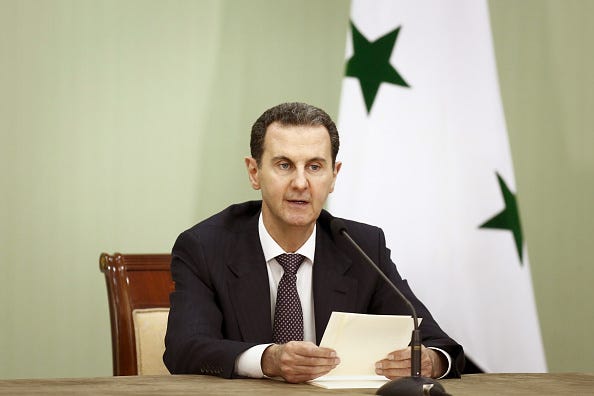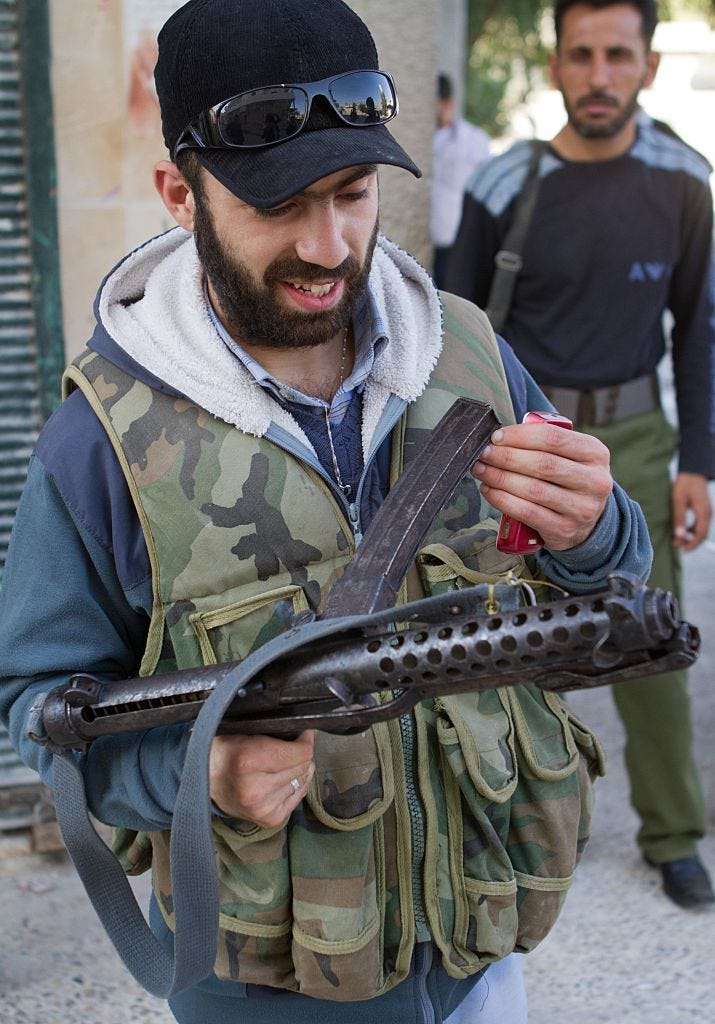Don’t have a lot of Time? Skip to my Idiot’s Guide to Syrian Civil War Factions below:
To start, YouTube demonetized this video, so thank you to everybody who gives me $5 a month on Substack. If you have the $5, I would really appreciate you joining here:
The Dog’s Breakfast
Syria is a mess with up to 70 factions fighting. The typical maps of Syria don’t do the conflict justice and show the sheer scale of independent factions as well as factions within factions. But why did anti-government forces make such quick gains after years of static front lines?
Here is a basic rundown of the conflict in a nutshell:
Bashar al-Assad is the President and Dictator of Syria.
He became the president of Syria in 2000 after the death of his father, Hafez al-Assad
Who ruled as President / Dictator of Syria from 1971 until the year 2000. Initially, Bashar al-Assad had no political ambitions, deciding to become a doctor and later an ophthalmologist in London. Most of the political power was directed at his older brother, Bassel al-Assad.
The older son, Bassel al-Assad died in a car crash in 1994, and Bashar al-Assad returned home to Syria to become the heir and consolidate power. He was introduced to the nation as the next leader by his father. Bashar immediately begins fighting “Corruption” - which is defined as anyone who opposes his rise to power. Bashar also becomes the president of the “Syrian Computer Club” and introduces the internet into Syria.
Hafez al-Assad dies in June of 2000. Bashar al-Assad becomes president in a bit of constitutional trickery that lowers the minimum age to become President of Syria from 40 to 34 - Bashar al-Assad’s age.
The “Damascus Spring” begins after Bashar attains power. Artists and intellectuals in Syria demand more reforms. Bashar al-Assad responds by throwing thousands of people in prison.
By 2011, the self-immolation death of Tunisian fruit vendor Mohamed Bouazizi sets the “Arab Spring” loose in the middle east. Syria faces waves of protests calling for government reforms.
Some Army factions defect from the military. Islamist and Kurdish militia groups form, openly battling government forces.
Syrian Forces use air power to attack rebel strongholds and civilian areas who support the rebels. This sees the advent of “Barrel Bombs” - 55 gallon drums that are packed with explosives and pushed out of helicopters.

The strategic city of Aleppo, which is rebel held and the crossroads of the M4 and M5 highways, becomes the main focus of pro-Assad forces.
ISIS, or the Islamic State of Iraq and Syria takes advantage of this power vacuum to rise to power in norther Iraq and eastern Syria.
The Russian Air Force and Army Steps in to fight both ISIS and anti-Assad Forces.
Forces loyal to Bashar Al-Assad capture Aleppo in 2016.

Factions in a nutshell
Factions can be broken two into two main camps:
Factions that support Bashar al-Assad
Factions that do not support Bashar al-Assad
Among the factions that support Bashar al-Assad are:
Russia - they have been a strategic ally of Syria since the cold war. Russia has one navy base and one aircraft base in the region. Syria is considered a “low risk” operation and a chance to hone the bombing skills of its pilots against people who don’t shoot back - namely ISIS. While the operation has a small footprint of roughly 4,000 troops, this may be harder to maintain as Russia’s war in Ukraine drags on.
Iran - Iran needs Syria to provide the final link in the Iran-Iraq-Syria-Lebanon pipeline of missiles to Hezbollah. Iran also uses this as a training ground for the IRGC.
Hezbollah uses Syria as a conduit for weapons it needs to fight Israel. Hezbollah has also used its special forces arm (of which these are genuine operators) to fight ISIS in Syria.
Among the factions that do not support Bashar al-Assad:
Islamist Groups
HTS or Hayat Tahrir al-Sham. This basically means "The Organization for the Liberation of the Levant" but more technically means "Levant Liberation Committee." They are kind of like an offshoot of Al Qaeda although a more moderate form of Al Qaeda. They've also fought Al Qaeda and arrested Al-Qaeda members.
Hurras al-Din, which means “The guardians of the Religious Organization.” They are also an offshoot of Al Qaeda. Although they consider ISIS heretics, although there are some ISIS sympathizers. And there have been tensions with Hurras al-Din and HTS.
Kurdish Groups
SDF - Syrian Democratic Forces - main US ally and the largest at 100,000 fighters. However they are tied to the Kurdish PKK militant movement in Southern Türkiye and Northern Iraq. Türkiye considers the PKK terrorists and by association the SDF. SDF is fighting against Assad, but also against ISIS and Islamist forces.
The YPG or People’s Protection unit. Largely based in and around northeastern Syria. They mainly fought ISIS but also fought government forces and fought the Turks. This init consists of Arabs and Kurds and is a major component of the SDF.
Moderate Anti-Assad rebel groups
Free Syrian Army. This is a bunch of combined rebel groups, including defectors from the government. Receives some support from Türkiye.
Syrian National Army. This is a Turkish backed coalition which is operating mostly in Northern Syria, But the Turkish-backed SNA is mostly interested in fighting the Kurdish SDF.
So what happened in Aleppo?
On November 27th, elements of HTS or Hayat Tahrir al-Sham entered Aleppo eventually pushing as far as the Airport.
Where they captured some Syrian Air Force aircraft, although the disposition of those aircraft an HTS’s ability to operate them is unknown.
HTS has also dropped instruction to pro-government forces on how to safely surrender. This is the first time I have ever seen a rebel army drop leaflets and the first time I have seen a QR code used in war.


Note that the pro-Syrian Army has suffered comparatively few losses compared with the land gained by the HTS - roughly 200 or so casualties. This means that pro-Assad forces are likely fleeing rather than fighting.
Why is this happening now?
There are three possibilities, or it is a combination of the three:
Russia simply can’t spend the money, troops and equipment needed to prop-up Syria while it simultaneously deals with Ukraine.
The peace treaty between Israel and Hezbollah removed two major sources of pro-Syrian backing: Hezbollah and Iran.
Hezbollah may have been attrited so much that it simply can’t fight in Syria anymore.
Iran may be pulling back from Syria to focus on defending it’s own airspace.
Anti-Assad forces may be moving with the understanding that the inauguration of President Donald Trump could bring a new dynamic to the war. It is possible that the US may cut off the Kurdish forces from more aid, which was lampooned in this Twitter post:
So the HTS may be performing a shaping operation - not against Assad, but to better position itself if Kurdish supported groups ave their funding cut off.
Note that I am just touching on several of the almost 70 factions fighting in Syria. It is impossible to cover all of them and the intricacies involved in their relations. But it’s best to just keep at at a high level. Here is a list of the factions in an handy infographic






























Share this post